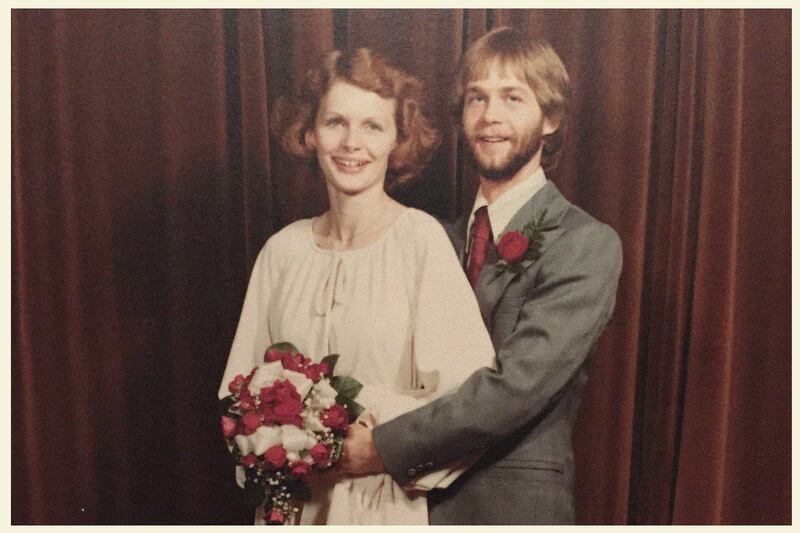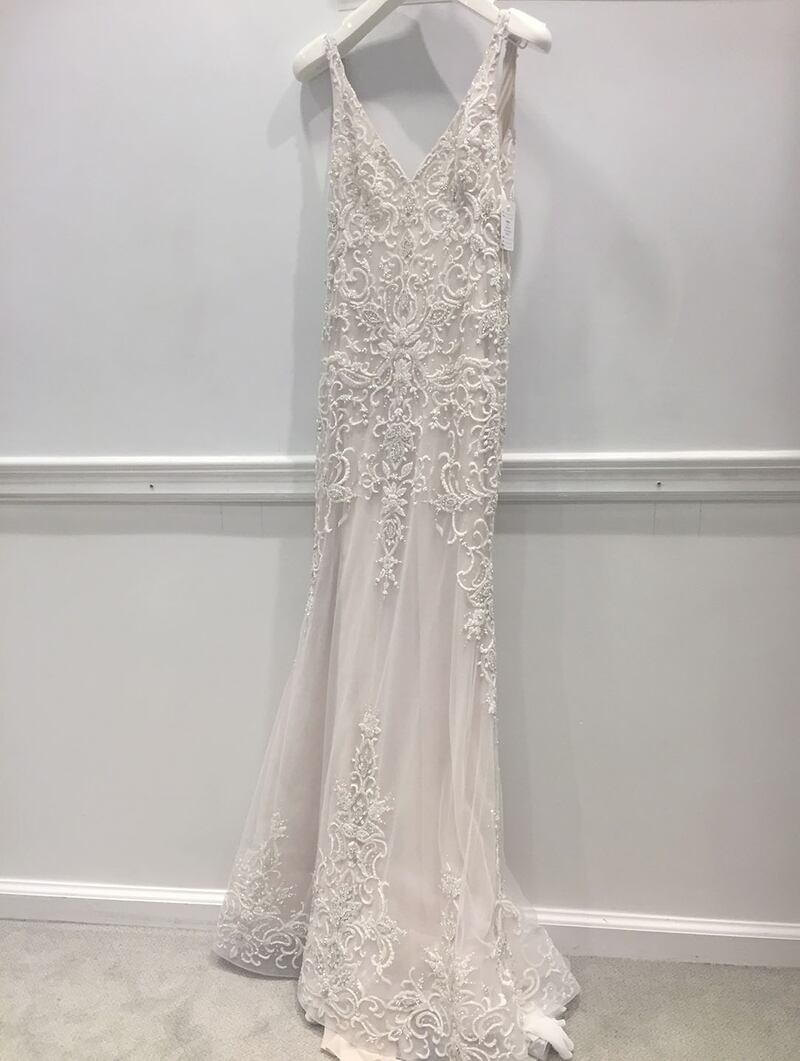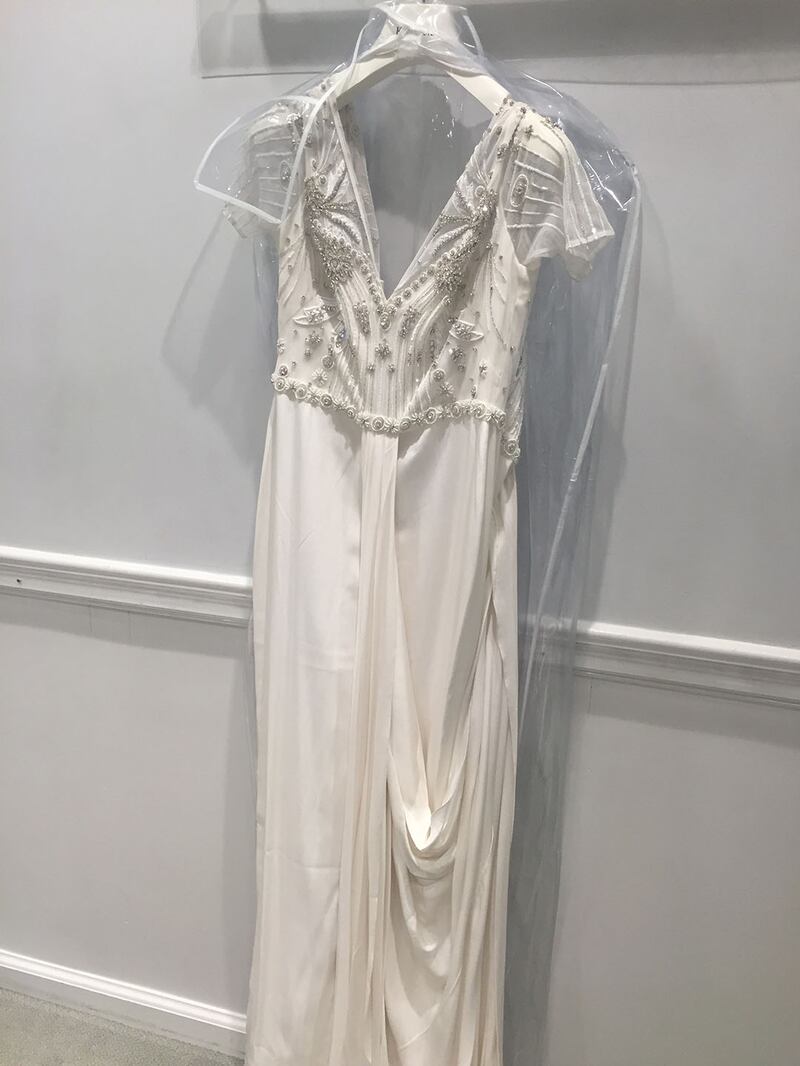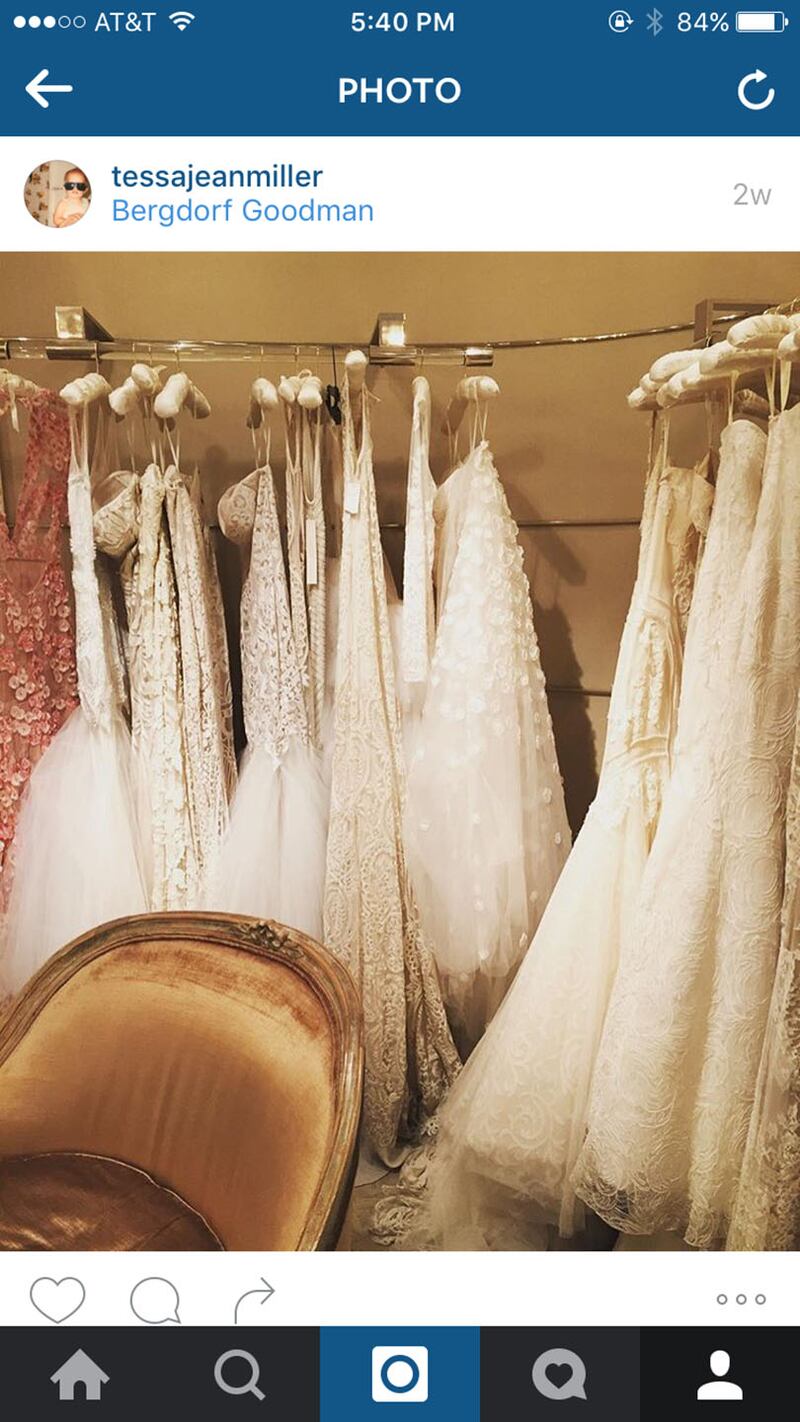I never wanted to get married. Marriage, in my family at least, seems heartbreakingly stupid. So how the hell did I find myself in Bergdorf Goodman’s bridal salon contemplating lace vs. tulle, sleeves vs. strapless?
I’m getting married on Oct. 9, 2016. Being Type A, I have the whole thing planned and it’s, as of writing, 322 days away. I’ve saved 394 photos of wedding dresses, tried on 16, and purchased one.
I’ve seen gowns traditional and non-traditional, plain and patterned, matronly and youthful. I guess I’m something of an expert now—but I never expected to be. And I never anticipated that searching for a dress that I’ll wear one time would bring back memories of the hardest kind.
ADVERTISEMENT
***

My dad, Michael, was a charming genius who moonlighted as an abusive alcoholic, and my mom, Jean, is stunningly beautiful but can be emotionally detached. (Despite this, I love them both so much it hurts.)
After sucking out each other’s souls for almost 30 years, they divorced when I was 12. My mom remarried when I was 18. My dad died when I was 20.
My dad’s mother, Edith, married his father, John, and birthed three babies, only to have her husband drop dead of a heart attack at 34.
Later, she married Elwin (“Doc”), the only grandfather I’ve ever had. He slowly shattered after she died of lung cancer in 2007. In tears, he once told me that my grandmother “had so much grace, she moved like a movie star.” Colon cancer took Doc a few years later.
My maternal grandmother, Irma, married my grandfather, Walter, at 17 (!). They met at some sort of community dance. He escorted her home in the rain, and to prevent her from ruining her shoes, he carried her to the door. Irma lost Walter six kids later to lung cancer.
On the day she found out he was terminally ill, she had a heart attack and spent days in intensive care. (My grandmother went on to live a long life full of grandkids and peach cobbler and Salem 100 cigarettes. She died peacefully in her sleep at the age of 87.)
My mom and dad got married at 22 and 24, respectively, after several years of long-distance dating. Dating then meant actual phone calls and letters—hundreds of handwritten letters and cards that my sister and I found while cleaning out my dad’s apartment.
It’s weird to read a bunch of love notes between people who you can only remember hating each other. It’s even weirder that he kept them for 40 years.
From what I understand, my grandparents didn’t want my parents to live together “in sin,” so they married in Doc and Edie’s living room on Christmas Eve, 1976.
My mom’s dress cost $150 and was made from polyester that disintegrated over time. She once told me that she thought about backing out on the day of the wedding. I wonder how her life would have been different—better, maybe—if she had.
My parents’ marriage wasn’t always bad, but I can’t remember it being good. By the time I hit junior high, my dad’s alcoholism had cost him his career in academia, so he holed up in a locked room binge drinking all day and night—only emerging to terrorize us.
He called my teenage sister a whore, smacked my mom in the face, kicked our dog, threw dinner plates into the backyard. He’d sometimes disappear for days or weeks at a time, leaving us to wonder if he was alive.
Then he’d sober up for a while, maybe even start taking antidepressants. He’d become the guy who played basketball in the driveway, went on 20-mile bike rides, devoured books, meditated, helped with math homework, taught me about reggae and jazz. My dad wasn’t a bad man, but he was very, very sick.
The last time I saw my parents together was July of 2001. My sister had escaped our home by then, and my mom had rented an apartment in preparation of leaving with me.
We tried to quietly gather our things from the house, but my dad emerged from his room in a fury, attacking my mom as we tried to flee. Eyes crazed and un-human, he called her a cunt (I later looked up what this word meant because I’d never heard it before; I was 12 years old, after all) and threw her car keys across the yard as we scrambled into the Mitsubishi and locked the doors.
We waited until he withdrew back inside, and I tore across the yard to grab the keys. He was arrested later that night.
My parents never spoke again.
***

Ten years later, I met my soon-to-be-husband, “N,” at a work event of sorts (if you can call interning for $12/day “work”). I thought he had the face of an angel. He asked for my number and said we should “kick it sometime.”
Our courtship consisted of getting drunk and having sloppy sex on the air mattress in my cockroach-infested apartment.
It was six months before I would even share a meal with him or reveal anything meaningful about myself. I would not recommend this approach if you’re trying to score a husband.
After five years and a lot of growing pains, our relationship is built from the clichéd stuff that I didn’t grow up with: honesty, friendship, humor, respect, and patience—plus we just like the hell out each other.
We aren’t committed for financial security or religion or “completion” as individuals or because we’ll breed genetic super-children (or any other reason that looks good on paper).
We look at marriage as the solidification of a promise we’ve already made to each other, a promise we’ll share with our closest family and friends.
I try not to make a big deal out of my parents’ cruel shambles of a marriage. My dad died full of pain, regret, and anger, and my mom is still so ashamed and traumatized that she barely speaks of it.
I feel sad for them both more than anything else. But you can understand how their example of marriage didn’t make me daydream about weddings or want to run to the alter.
If I were writing a how-to guide on purchasing the perfect wedding dress—which is what this article is supposed to be—this would be my first step: Find a partner you don’t hate. Preferably one you love.
Next?
Step Two: Go through something life-changing together, like almost dying.

I have Crohn’s disease, which makes my immune system think my digestive system is a foreign invader. My body attacks itself over and over and over again, causing life-threatening damage to my digestive tract and making day-to-day living more painful and exhausting than it needs to be.
I take a bunch of heavy-duty medicine, like Remicade and long-term steroids. Meds sometimes work, but I’m in and out of the hospital a lot. There is no cure for Crohn’s yet, so I’ll have the disease for life, stuck in an endless cycle of flares and remissions.
This March, I got sick—not just a little sick, not just the kind that goes away like a cold. I was in the hospital for three months. My digestive tract was trying to claw and bleed its way out of my body, all while being destroyed by Clostridium difficle (C diff) and septic E coli infections.
I lost 20 pounds. My skin turned gray and hung from my bones. I wore diapers. I repeatedly went into shock from experimental treatment. My veins exploded, leaving me covered in bruises.
The best doctors in New York City didn’t know how to treat me. It’s the closest to death and most helpless I’ve ever been.
N knew next to nothing about the health-care system—he gets a sore throat once a year and hasn’t gone to the doctor in our five years together—let alone how to advocate for someone trapped in it. But he learned quickly, researching what he could about my disease and asking questions.
He came to the hospital every chance he could—sometimes several times a day—even when I didn’t have the energy to speak or open my eyes. My appetite was nonexistent but I violently craved root beer; N would bring me multiple bottles and different brands to try each day.
My mom came from Illinois and stayed for three weeks to care for me. Since I lived at the hospital, she and N were essentially roommates—sharing meals and working out schedules to walk our dogs, get groceries, and do laundry.
Under normal circumstances, my mother and boyfriend living together would be terrifying, but these were anything but normal. It was actually comforting to know they had each other.
After months of navigating the maddening hospital system, a doctor at Columbia agreed to give me a fecal transplant (FMT)—a lifesaving procedure that cures C diff 98 percent of the time. (I had a FMT in 2013 after five months of recurrent C diff—it eradicated the infection in 48 hours. I wrote about that in depth here.)
With my life on the line, I needed a stool donor pronto. To cure C diff, doctors take the stool of a healthy person—full of good bacteria—and transplant it mixed with saline, via colonoscopy, into the gut of the sick person.
The good bacteria repopulate the gut, overtaking the deadly bacteria. It’s a simple idea, really, one that dates back centuries.
N volunteered without hesitation, going through the rigorous testing process to get approved. He collected and boxed up his own shit not one but three times, once for testing and twice for the transplants.
When I was well enough to come home in June, he helped me bathe, dress, eat, and take medicine. He combed my hair because I was too weak, did the household chores, took me to doctor’s appointments and Remicade infusions, and ran all of my errands. Did I mention N has two jobs on top of being a musician?
There is no way I can adequately describe the resolve he showed in our darkest hour. And there’s something romantic about sharing microbiota, no?
Step Three: Get engaged.
This is the easy part. After you realize you’re going to live, you’ll probably start thinking about your future and a lot of other heavy stuff.
If you love someone, you might realize you don’t ever want to be away from him or her. Buy a ring if that’s what you’re into, say some nice stuff about each other, and change your Facebook status to “Engaged.”
Maybe post to Instagram, too. Rake in those likes. You won’t get this many until you get a puppy or have a baby, so soak it in.
If you don’t want or can’t afford a ring, don’t let the Wedding Industrial Complex make you believe it’s necessary. A ring is fun to show off, but it won’t change how you feel about your partner.
Step Four: Don’t lose your mind.
After you’re officially engaged, you’ll start exploring the hellish underground that is the Wedding Internet. The Wedding Internet likes to focus on THE DRESS, and you’ll be overwhelmed by what bridal blogs call the most important thing you’ll EVER. WEAR. IN. YOUR. FEMALE. LIFE!!!!!!!
It’s not. The tank top I bought for $9 and wore to a Neil Young concert where my dad cried is more important. The high school volleyball sweatshirt I had on when my niece was born is more memorable. The flannel shirt I repeatedly steal from my fiancé makes me feel more at home.
Don’t lose your mind over what is, at the end of the day, just a dress.
Step Five: Start a Pinterest.
It’s a hotbed for Mormon mommy bloggers who name their kids “Heavyn,” but it’s also really convenient for saving photos of dresses, finding silhouettes or details you might like, getting familiar with designers, and wrapping your head around a budget.
Screenshotting pictures on your phone or saving links in an email draft (my original plan) will only make your head explode, so save yourself the trouble and starting pinning. Ugh, I said “pinning.”
Step Six: Set a budget.
Set a realistic attire budget (8-10 percent of your overall wedding budget is reasonable), and most importantly, stick to it. You will see dresses you love that are twice what you can afford.
Do not try them on, even for fun. With help from the Internet, you can usually find a store’s base price. Do not even go to a store with a base price above your budget—it will only disappoint you and make you sad, which is what “they” want. Resist!
Seek out sample sales, trunk shows, or stores that are going out of business. I tried on a stunning hand-beaded Naeem Khan gown, for example, that was 50 percent off because the boutique was closing.
Look online for second-hand dresses or, even better, never-before-worn gowns from brides who changed their minds (or their partners), or from stores directly.
Sometimes they list out-of-season or discounted dresses on websites like Tradesy. Etsy is also a goldmine for affordable new and vintage gowns.
If you decide to order a dress online, be sure to take your body’s measurements so that you don’t buy something unwearable, and factor in the height of your shoes when you measure for length.
Most importantly, find a professional tailor. They can work magic. (Count tailoring into your budget as it can get expensive!)
Step Seven: Make appointments at several stores and decide who you’ll bring with you.

Once you’ve set a budget, make appointments at at least three different stores. I recommend trying a combination of small boutiques and larger department stores—you’ll discover very quickly which experience you prefer. I went to three places: Mociun White, Kleinfeld, and Bergdorf Goodman.
Mociun White, which recently closed, was an offshoot of the Mociun jewelry brand.
I brought N along to this appointment because I didn’t want to go alone, and neither of us is very superstitious.
The space was minimal and intimate, and we were the only people there except for our wonderful consultant. She asked me about our wedding and my personal style, looked at some photos I had pinned (see?!), and helped me search through the three or four racks of dresses.
I chose six to try, everything from a silk velvet trumpet style to a floral halter ball gown. My favorite of the bunch was the Naeem Khan I mentioned earlier, a stunningly detailed gown with three-quarter sleeves, layers of lace, and matte beading.
N’s favorite was a form-fitting, cream-colored gown with lace detailing resembling a computer’s motherboard. I didn’t purchase a dress that evening for two reasons: because I wanted to shop with my sister (my best friend and matron of honor), and because the Wedding Internet had convinced me that I’d cry when I found THE DRESS.
On to the next.
I watched a lot of Say Yes to the Dress while in the hospital high on opiates, so I blame the hydromorphone for making me think I just had to go to Kleinfeld Bridal even though department stores give me hives.
With my sister at my side, I arrived there for a 4:30 appointment. There were hysterical brides, mothers of brides, and bridesmaids everywhere. I was instantly itchy.
Our consultant appeared at 4:45, looking frazzled, and rushed us into a poorly lit dressing room. She asked me three or four questions before disappearing into the stock room (at Kleinfeld, you aren’t allowed to choose the dresses you try on; even browsing the racks is discouraged).
I hated everything my consultant chose except a Temperley with a beaded, short-sleeved top and draped bottom, which she was trying to sell me hard. We were out of there in an hour.
Onward!
Ah, the sweet heaven that is Bergdorf Goodman.
The lighting is low, shoes and clothes are displayed in individual rooms like museum objects, and there’s a bar. A bar!
The bridal salon is small and quiet and the perfect palette of cream, blush, and gold. My consultant handed us champagne immediately and asked a bunch of questions while taking copious notes.
She helped me browse the racks, explaining the designers, the fabrics, even the production process. This woman was clearly a pro.
I picked a handful of gowns to try on: a long-sleeved Oscar de la Renta ball gown that weighed at least 20 pounds, a layered tulle Monique Lhuillier with subtle beading, a matte satin Austin Scarlett with a trumpet skirt, an Ines Di Santo with oatmeal-colored details and a high neckline, and a strapless Reem Acra with layers of vintage lace and intricate Art Deco details. (I won’t say which one I chose because N might read this and I’m suddenly superstitious. Sorry!)
My consultant was hilariously honest, which some people might not appreciate but I loved.
We laughed hysterically at a dress that made me look like a Pilgrim showgirl, and another that she nicknamed “the Idaho potato.” It felt like I was trying on dresses with a kooky aunt.
I knew immediately which one was THE DRESS, but I didn’t cry. My sister did, and my consultant couldn’t stop raving about it. It was one of the least expensive dresses I tried and she gave me a discount and a free veil, so I’m confident she wasn’t in it for the commission.
Even my mom, who says she “isn’t the mother of the bride type,” teared up when I sent her photos. That was sign enough for me.
So, I didn’t cry. But I laughed. I twirled. I felt beautiful, comfortable, and most importantly, like myself.
Step Eight: I repeat: Don’t lose your mind.
The wedding industry makes billions—$86 billion, according to the Library of Congress—on “perfection.” You will, at some point, feel like you need to buy hair extensions, get Botox, and lose 20 pounds to look decent in a wedding dress.
The underlying message of that, of course, is that you aren’t worthy of love or marriage without completely changing yourself. Grooms, on the other hand, are required to show up.
Even after you find THE DRESS, you might second-guess how you look in it. It’s beautiful, but imagine how it would look with (fill in the blank: narrower hips, larger breasts, unmarked skin)! Don’t play this game. You’ll always lose.
Step Nine: Stop looking.
Even after you’ve found and paid for (gulp) your dream dress, you’ll be tempted to keep looking around.
You’ll probably see a gown or two that will make you second-guess the one you chose. As hard as it is to put on blinders, try your best. Unfollow designers or boutiques on Instagram. Throw away your bridal magazines. Burn your mood board. Focus on how you felt in your dress.
And for god’s sake, stop pinning.
Step Ten: Let it go.
As much as you fight it, your emotions will get tangled up in those swaths of crinoline and chiffon. You’ll find yourself thinking about your dead dad and how he can’t walk you down the aisle, when you should be considering bustles.
You might get misty-eyed remembering a photograph of your teenage grandmother on her wedding day, and you’ll have to pretend you’re crying for your own happiness.
A glimpse of yourself in a gown might make you wonder if someday, you and your partner will hate each other, too.
Breathe. Commitment is a mysterious, hard thing, one that we jump into without really knowing what we’re doing. You can’t face an impending marriage without thinking, at least a little bit, about your family history and the relationships you’re succeeding.
But at the end of the day, don’t forget: it’s just a dress.
Floral design: MaidenkindHair/Makeup: Angela BosworthDress: Maggie Soterro






